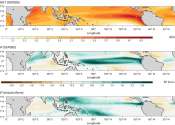Bilbies could hop back into mild climate zones, study finds
Bilbies bred in a sanctuary in Dubbo have provided researchers with vital clues about how they would fare in temperate Australia where they once thrived.

Bilbies bred in a sanctuary in Dubbo have provided researchers with vital clues about how they would fare in temperate Australia where they once thrived.
Plants & Animals
9 hours ago
0
49

This Copernicus Sentinel-2 image features salt flats and lakes in southwest Bolivia, near the crest of the Andes Mountains.
Planetary Sciences
5 hours ago
0
19

As the U.S. Environmental Protection Agency cracks down on insidious "forever chemical" pollution in the environment, military and commercial aviation officials are seeking ways to clean up such pollution from decades of ...
Environment
May 9, 2024
0
73

Does life exist beyond Earth? One of the most compelling places to consider this possibility is Enceladus, a moon of Saturn with a liquid water ocean encased in a frozen shell. There, plumes of water spray from ice fractures ...
Astrobiology
May 9, 2024
1
186

A new model for predicting the effects of climate change on malaria transmission in Africa could lead to more targeted interventions to control the disease according to a new study.
Ecology
May 9, 2024
0
15

Georgia Tech researcher Jie He set out to predict how rainfall will change as Earth's atmosphere continues to heat up. In the process, he made some unexpected discoveries that might explain how greenhouse gas emissions will ...
Earth Sciences
May 9, 2024
0
7

In media articles about unprecedented flooding, you'll often come across the statement that for every 1°C of warming, the atmosphere can hold about 7% more moisture.
Earth Sciences
May 9, 2024
0
45

There were early warnings that Kenya's long rain season—between March and May—was going to bring above-normal rainfall. The extreme intensity of the rain has resulted in devastating floods in many parts of the country. ...
Environment
May 9, 2024
0
1

A new paper in Oxford Open Climate Change indicates that extensive bleaching and deaths are widespread at several major coral reefs around the world. This suggests that climate change has resulted in shifting patterns in ...
Earth Sciences
May 9, 2024
0
5

The dazzling Thai holiday islands made famous by Hollywood film "The Beach" are facing a severe water shortage following a blistering heatwave across Asia, a tourism official and locals said Thursday.
Environment
May 9, 2024
0
30
Water is a ubiquitous chemical substance, composed of hydrogen and oxygen, that is essential for the survival of many known forms of life. In typical usage, water refers only to its liquid form or state, but the substance also has a solid state, ice, and a gaseous state, water vapor or steam. Water covers 71% of the Earth's surface. On Earth, it is found mostly in oceans and other large water bodies, with 1.6% of water below ground in aquifers and 0.001% in the air as vapor, clouds (formed of solid and liquid water particles suspended in air), and precipitation. Saltwater oceans hold 97% of surface water, glaciers and polar ice caps 2.4%, and other land surface water such as rivers, lakes and ponds 0.6%. A very small amount of the Earth's water is contained within biological bodies and manufactured products. Other water is trapped in ice caps, glaciers, aquifers, or in lakes, sometimes providing fresh water for life on land.
Water moves continually through a cycle of evaporation or transpiration (evapotranspiration), precipitation, and runoff, usually reaching the sea. Winds carry water vapor over land at the same rate as runoff into the sea. Over land, evaporation and transpiration contribute to the precipitation over land.
Clean, fresh drinking water is essential to human and other lifeforms. Access to safe drinking water has improved steadily and substantially over the last decades in almost every part of the world. There is a clear correlation between access to safe water and GDP per capita. However, some observers have estimated that by 2025 more than half of the world population will be facing water-based vulnerability. Water plays an important role in the world economy, as it functions as a solvent for a wide variety of chemical substances and facilitates industrial cooling and transportation. Approximately 70 percent of freshwater is consumed by agriculture.
This text uses material from Wikipedia, licensed under CC BY-SA